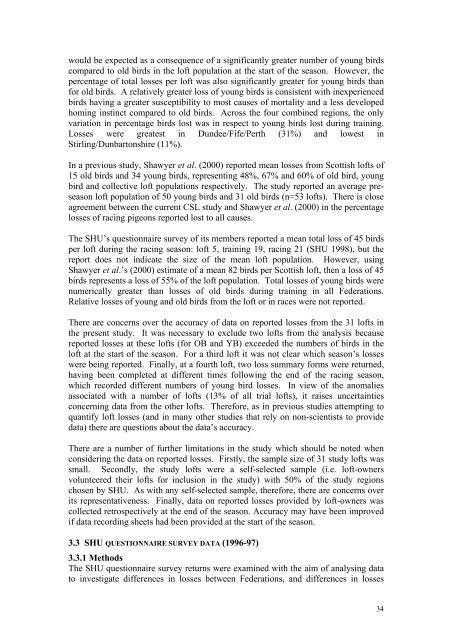RACING PIGEONS â IMPACT OF RAPTOR PREDATION
RACING PIGEONS â IMPACT OF RAPTOR PREDATION
RACING PIGEONS â IMPACT OF RAPTOR PREDATION
Create successful ePaper yourself
Turn your PDF publications into a flip-book with our unique Google optimized e-Paper software.
would be expected as a consequence of a significantly greater number of young birds<br />
compared to old birds in the loft population at the start of the season. However, the<br />
percentage of total losses per loft was also significantly greater for young birds than<br />
for old birds. A relatively greater loss of young birds is consistent with inexperienced<br />
birds having a greater susceptibility to most causes of mortality and a less developed<br />
homing instinct compared to old birds. Across the four combined regions, the only<br />
variation in percentage birds lost was in respect to young birds lost during training.<br />
Losses were greatest in Dundee/Fife/Perth (31%) and lowest in<br />
Stirling/Dunbartonshire (11%).<br />
In a previous study, Shawyer et al. (2000) reported mean losses from Scottish lofts of<br />
15 old birds and 34 young birds, representing 48%, 67% and 60% of old bird, young<br />
bird and collective loft populations respectively. The study reported an average preseason<br />
loft population of 50 young birds and 31 old birds (n=53 lofts). There is close<br />
agreement between the current CSL study and Shawyer et al. (2000) in the percentage<br />
losses of racing pigeons reported lost to all causes.<br />
The SHU’s questionnaire survey of its members reported a mean total loss of 45 birds<br />
per loft during the racing season: loft 5, training 19, racing 21 (SHU 1998), but the<br />
report does not indicate the size of the mean loft population. However, using<br />
Shawyer et al.’s (2000) estimate of a mean 82 birds per Scottish loft, then a loss of 45<br />
birds represents a loss of 55% of the loft population. Total losses of young birds were<br />
numerically greater than losses of old birds during training in all Federations.<br />
Relative losses of young and old birds from the loft or in races were not reported.<br />
There are concerns over the accuracy of data on reported losses from the 31 lofts in<br />
the present study. It was necessary to exclude two lofts from the analysis because<br />
reported losses at these lofts (for OB and YB) exceeded the numbers of birds in the<br />
loft at the start of the season. For a third loft it was not clear which season’s losses<br />
were being reported. Finally, at a fourth loft, two loss summary forms were returned,<br />
having been completed at different times following the end of the racing season,<br />
which recorded different numbers of young bird losses. In view of the anomalies<br />
associated with a number of lofts (13% of all trial lofts), it raises uncertainties<br />
concerning data from the other lofts. Therefore, as in previous studies attempting to<br />
quantify loft losses (and in many other studies that rely on non-scientists to provide<br />
data) there are questions about the data’s accuracy.<br />
There are a number of further limitations in the study which should be noted when<br />
considering the data on reported losses. Firstly, the sample size of 31 study lofts was<br />
small. Secondly, the study lofts were a self-selected sample (i.e. loft-owners<br />
volunteered their lofts for inclusion in the study) with 50% of the study regions<br />
chosen by SHU. As with any self-selected sample, therefore, there are concerns over<br />
its representativeness. Finally, data on reported losses provided by loft-owners was<br />
collected retrospectively at the end of the season. Accuracy may have been improved<br />
if data recording sheets had been provided at the start of the season.<br />
3.3 SHU QUESTIONNAIRE SURVEY DATA (1996-97)<br />
3.3.1 Methods<br />
The SHU questionnaire survey returns were examined with the aim of analysing data<br />
to investigate differences in losses between Federations, and differences in losses<br />
34
















